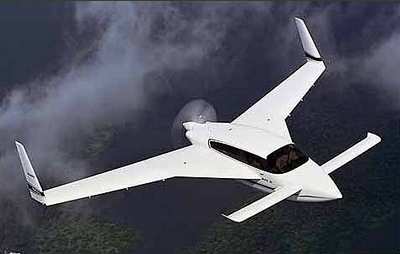First Time Plane Flew With Forced Induction Device Engaged
 Editor's Note:
Below is the unedited text of the National Transportation
Safety Board's preliminary report on last week's fatal crash of a
Velocity 173RG in North Las Vegas, NV.
Editor's Note:
Below is the unedited text of the National Transportation
Safety Board's preliminary report on last week's fatal crash of a
Velocity 173RG in North Las Vegas, NV.
Of note is the fact the accident flight was to be the first
with the engine's supercharger engaged. According to the
owner/builder of the aircraft, several high-speed taxi tests had
been conducted with the supercharger engaged in the days prior to
the accident.
As ANN reported, the plane crashed into a
home last Friday, just after takeoff from the North Las Vegas
Airport (VGT). The accident claimed the lives of pilot Mack
Creekmore Murphree Jr., 76, and two people living inside the home,
identified as Jack and Lucy Costa.
NTSB Identification: LAX08LA274
14 CFR Part 91: General Aviation
Accident occurred Friday, August 22, 2008 in North Las Vegas,
NV
Aircraft: Killgore M/Killgore K Velocity 173RG, registration:
N415MK
Injuries: 3 Fatal.
This is preliminary information,
subject to change, and may contain errors. Any errors in this
report will be corrected when the final report has been
completed.
On August 22, 2008, at 0628 Pacific
daylight time, an experimental Killgore M/Killgore K Velocity
173RG, N415MK, collided with a residential building in North Las
Vegas, Nevada. The airplane is registered to the owner/builder and
it was being operated by the pilot under the provisions of 14 Code
of Federal Regulations Part 91. The certificated airline transport
pilot and two people on the ground were killed. Post impact fire
destroyed the airplane and partially burned the residence. The
local flight departed North Las Vegas Airport at 0627. Visual
meteorological conditions prevailed, and no flight plan had been
filed.
Preliminary information obtained from
the Federal Aviation Administration (FAA) revealed that the
airplane departed North Las Vegas from runway 12 left. Shortly
after takeoff the air traffic controller observed that the airplane
was not gaining altitude. The controller asked the pilot if he
needed assistance, to which the pilot responded, "I'm going down,
I'm going down." The airplane then collided with a house 1.1 miles
southeast of the airport.
The owner/builder was interviewed by
the National Transportation Safety Board investigator-in-charge
after the accident. He reported that the engine was equipped with a
supercharger, and that the purpose of the flight was to test the
performance of the airplane and engine with the supercharger
engaged. He further reported that the supercharger was tested on
multiple occasions during high speed taxi tests and ground runs the
week prior to the accident, but that this was to be the first time
it would be engaged for flight.
The pilot held an airline transport
pilot certificate with ratings for airplane single engine land,
multiengine land, and instrument airplane. He additionally held a
flight engineer certificate, mechanic certificate, and a flight
instructor certificate for airplane single engine, multiengine, and
instrument airplane. On his latest FAA third-class medical
application, dated September 7, 2006, the pilot stated that he had
amassed 6,250 hours of total flight time.

The canard configuration, four-seat,
low-wing, retractable gear airplane, was issued a Special
Airworthiness Certificate on March 9, 2008. It was powered by a
Lycoming IO-360-C1C, engine and equipped with a three bladed
MT-Propeller, model MTV-18-B.
The Experimental Amateur-Built
Airplane Operating Limitations for the accident airplane specified
the following compliance under the section: Phase 1
Limitations-Initial Flight Testing,
'After a minimum time of (5) hours,
and after controllability, airworthiness, and safety checks
required by FAR 90.319(b) and chapter 4 of Advisory Circular 90.89A
are established and recorded in the airplane logbook the airplane
then may complete the remaining hours required in Phase 1 while
based at North Las Vegas Airport (VGT); OR, a one time flight to
the "Airplane Base of Operations" may also be conducted remaining
clear of all densely populated areas and congested airways. NOTE:
Airplane Base of Operations: Show Low Regional Airport (KSOW). This
airplane must be operated for at least 25 (Twenty Five) hours in
the assigned geographic areas'
Review of the airplane maintenance
logbook records revealed that on March 17, 2008, the airplane had
amassed a total flight time of 5.1 hours. A logbook entry for that
date noted, 'This airplane meets all the controllability,
airworthiness, and safety checks required by FAR 91.319(b) and
chapter 4 of advisory circular 90-89A.'
 ANN's Daily Aero-Linx (05.06.25)
ANN's Daily Aero-Linx (05.06.25) ANN's Daily Aero-Term (05.06.25): Ultrahigh Frequency (UHF)
ANN's Daily Aero-Term (05.06.25): Ultrahigh Frequency (UHF) ANN FAQ: Q&A 101
ANN FAQ: Q&A 101 Classic Aero-TV: Virtual Reality Painting--PPG Leverages Technology for Training
Classic Aero-TV: Virtual Reality Painting--PPG Leverages Technology for Training Airborne 05.02.25: Joby Crewed Milestone, Diamond Club, Canadian Pilot Insurance
Airborne 05.02.25: Joby Crewed Milestone, Diamond Club, Canadian Pilot Insurance




